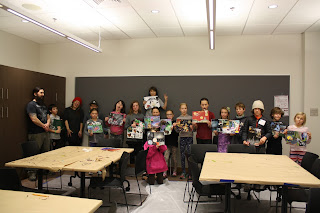The Exploring the Arts youth activity program is one of our most popular offerings here at the Alaska State Library, Archives, and Museum, and it is made possible by the
Friends of the Alaska State Library, Archives, and Museum and a
grant from the City and Borough of Juneau. This past year, we offered 13 workshops to 356 Juneau youth with Alaskan artists from around the state. We made books, sculpted clay, constructed collages, drew dog portraits, painted landscapes, decorated masks, made hats, and learned about Alaska.
In October, local author Susi Gregg Fowler and illustrator Jim Fowler led an Alaska book workshop. Participants learned about crafting a narrative and sketching from life. They saw how the Fowlers incorporate elements from their own lives into their stories and pictures and saw Alaska represented in their books. Then they created their own books, working in the Library and Archives' Research Center, surrounded by Alaska historical materials.
 |
| Jim and Susi signing their most recent book, Arctic Aesop's Fables. Photo courtesy of Susi Gregg Fowler. |
 |
| Participants hard at work on their original stories and illustrations. |
In November, two of the Alaska State Museum's 2017-2019 Solo Artist exhibitions opened at the Museum, and the artists each led a workshop for kids. Annette Bellamy, a large-scale sculptor from Halibut Cove, toured the kids through her exhibit Moving Mountains and then taught them clay sculpting techniques. Participants created their own clay sculptures, incorporating found objects they brought from home, and worked together to create a clay village that included a museum, a Walmart, houses, and a giant lizard (all the elements of a thriving village).
 |
| Annette and the kids circle her kinetic sculpture, the centerpiece of the Moving Mountains exhibit. |
 |
| The collaborative village included a museum with natural history specimens, artwork, and a visitor contemplating the exhibits. |
Daniel Papke of Skagway shared his exhibit, Lost Language, a series of oil paintings that told the story of a young woman on a journey to find her ancestral language. Then he led participants in creating layered artworks that incorporated collage and painting to introduce motifs and visual story elements. Each participant practiced storytelling techniques by sharing their painted collage and the accompanying story with the group.
 |
| Daniel shared some tips that he uses in his paintings when developing a visual story. |
 |
| A participant shares his story about a man in a yellow hat who travels the world until he finds a new, purple hat. |
Early January was winter break for Juneau kids, so we held a Fun with the Family Fair at the APK. Check out our
previous post for a detailed report about the fair.
In February, local artist Nobu Koch led a dog portrait drawing activity. Kids loved looking at photos of dogs from our Historical Collections and each other's family dog photos, and then creating their own portraits. We even had live dog models who posed for some quick sketching exercises.
 |
| Debbie, our administrative officer, brought in her dog, Nikita, to model for the kids. |
 |
| A participant shares her portrait of her dog, Pepper, playing outside in a field on a sunny day. |
In March, Anchorage painter Linda Infante Lyons opened her exhibit, Ebb and Flow, and led kids in creating landscape paintings. They learned about creating distance using color and value and painted volcanoes and island scenes.
 |
| Touring Ebb and Flow with Linda. |
 |
| Adding small trees to the island landscape. |
In April, arts educator Daniel Todd taught kids about the history of masks in cultures around the world. They practiced artistic techniques of sketching and designing their masks and then implementing those designs on papier-mache mask bases using paint, feathers, beads, and other found objects.
 |
| Dan demonstrates a sketching technique. The kids around him have their mask bases ready for decoration. |
 |
| Two participants show off their masks. |
 |
| These masks incorporated feathers, beads, ears, and other interesting appendages. |
|
|
|
In May, we hit the high seas and took the youth activity program to Maritime Fest. We made Alaska Steamship Company captain's hats, Unangan-inspired visors, and sugar cube lighthouses with our community partner, the Cape Decision Lighthouse Society.
 |
| A jaunty captain and his siblings making sugar cube lighthouses at Maritime Fest. |
 |
| The captain's hats were a big hit. One Coast Guard captain said that he saluted every young captain who went by. |
We love the youth activity program here at the APK and are excited to announce that the Friends have received a grant for FY19 to continue the program. We look forward to bringing you more fun art opportunities for kids starting in October 2018! To get notifications about these workshops, visit
Youth Art Activities at the APK and sign up to receive e-announcements.
These programs are partially funded by the citizens of the City and Borough of Juneau through sales tax revenues and are sponsored by the Friends of the Alaska State Library, Archives, and Museum.







































